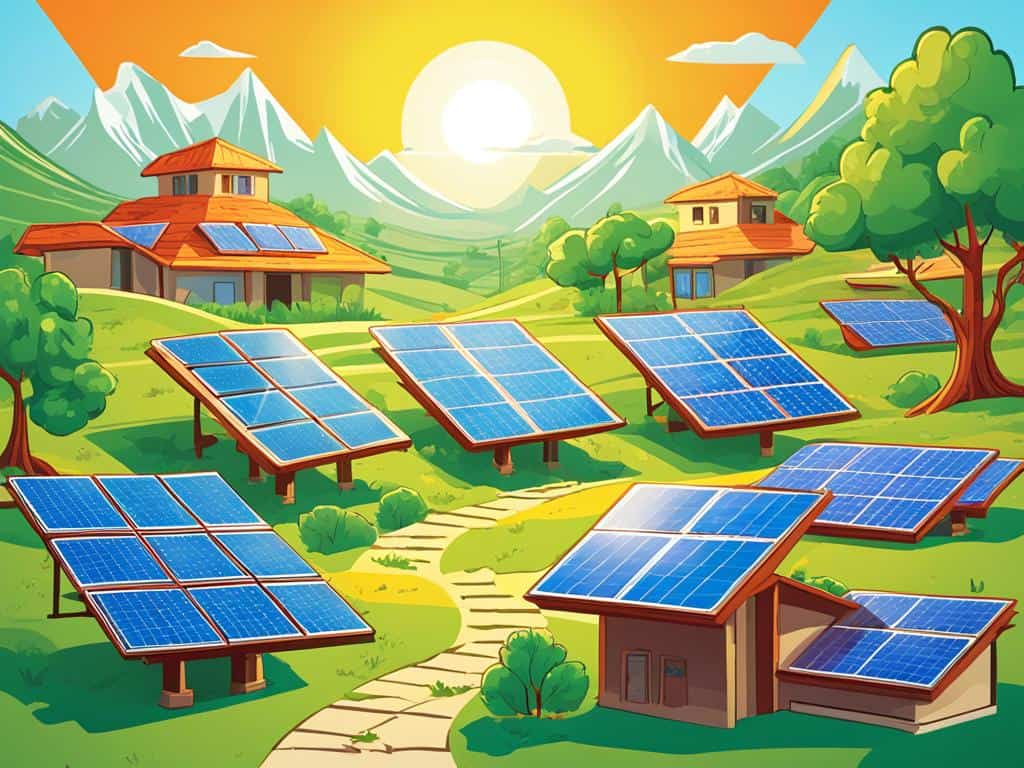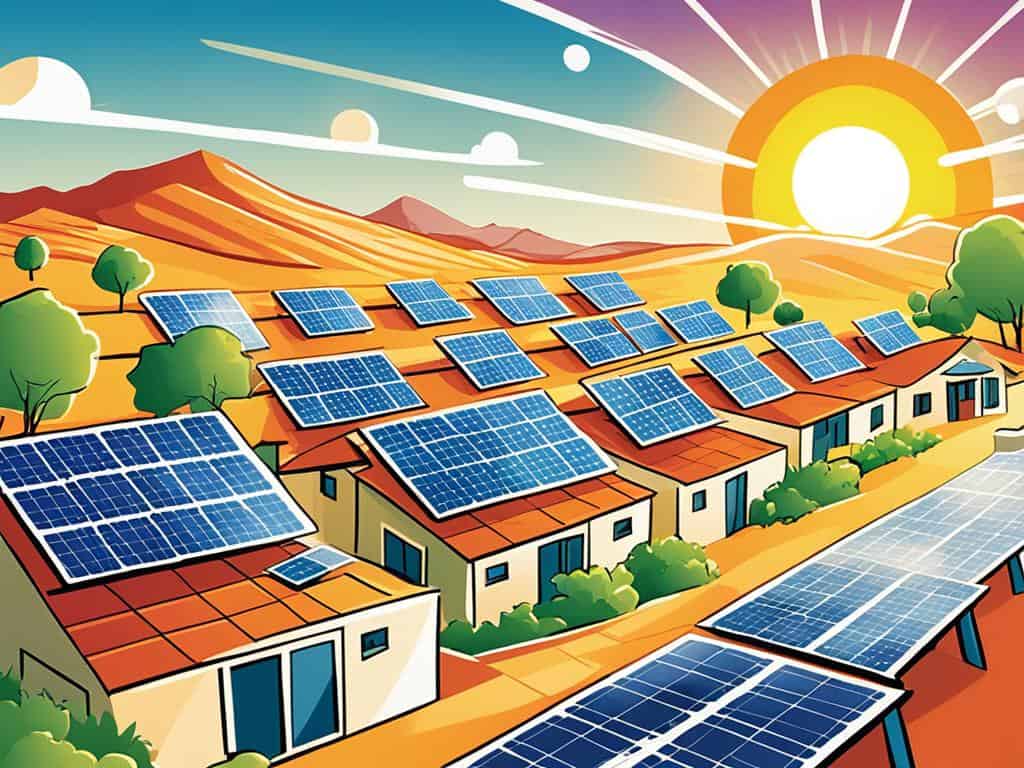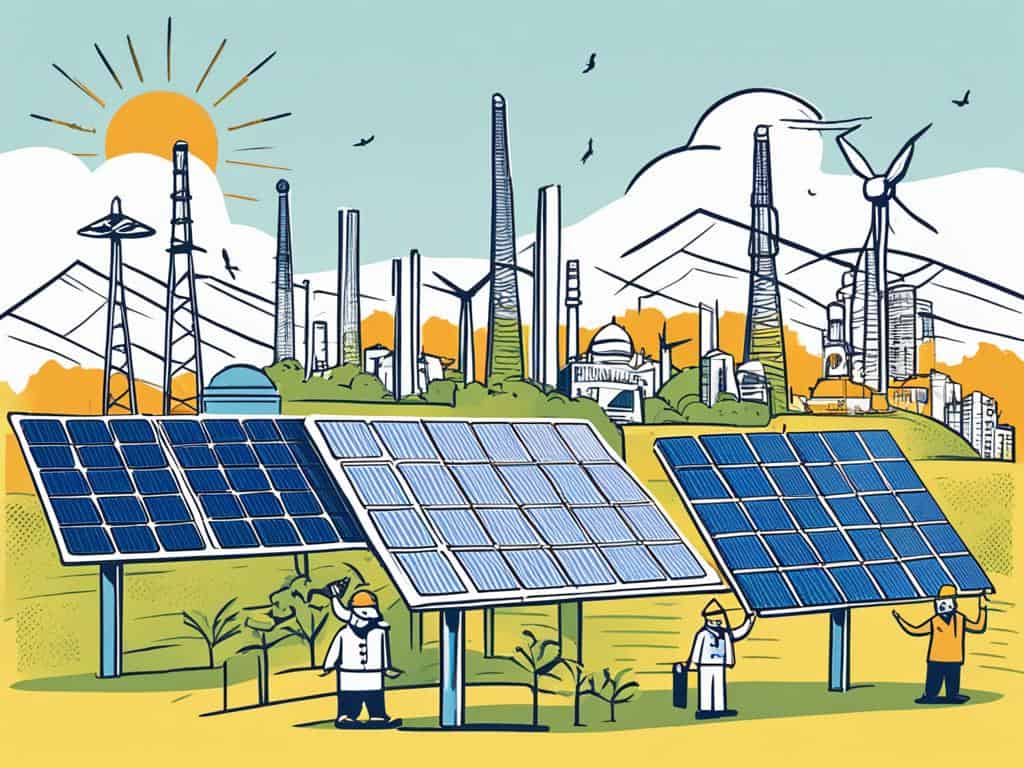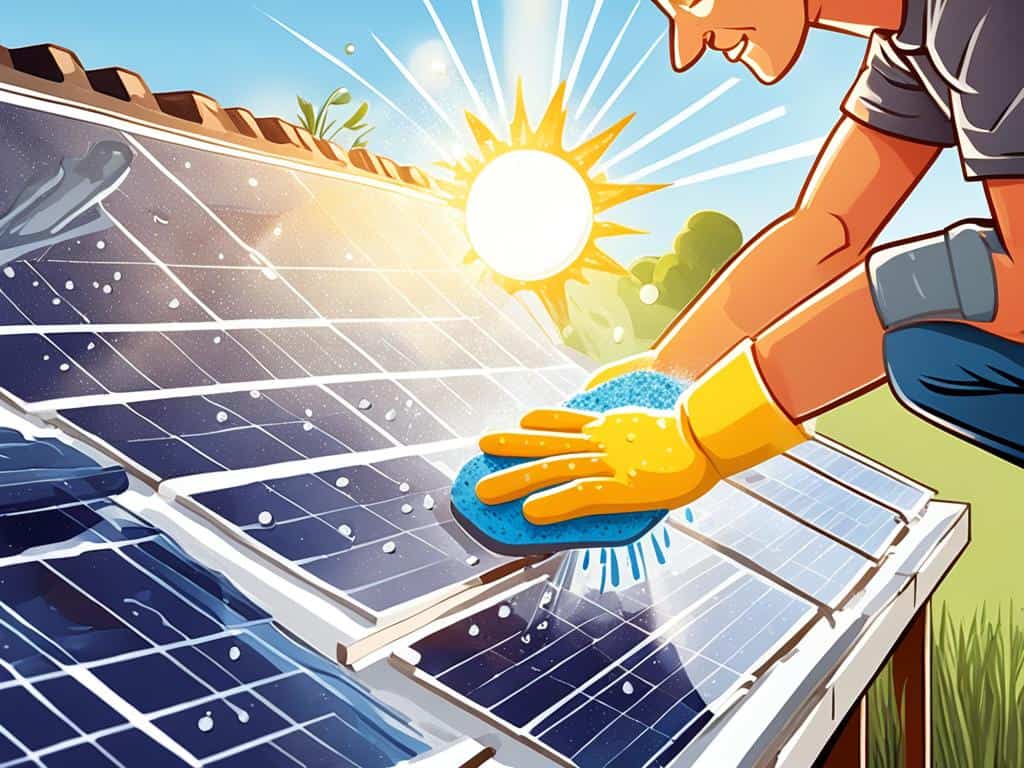Comparing Climates: A Look at Solar Panel Choices Across India
Discover your ideal solar options with our comprehensive solar panel comparison India, tailored to match the diverse Indian climates and energy needs.

India is facing big energy needs and environmental issues. Solar energy shines brightly here, tapping into the sun’s wealth. The choice of solar panels varies with India’s diverse climate. This makes picking the right option both complex and crucial.
The Star Labelling Programme for solar panels is steering the market towards greener futures. By 2030, the goal is to cut carbon emissions by 30 million tonnes a year. ‘Made in India’ solar panels are getting a push, boosting local making and energy independence.
Switching from a 1-Star to a 5-Star rated solar panel can boost your energy greatly—by up to 35%. The growth in solar power is evident. Gujarat and Delhi are leading with huge solar developments. This search for efficient solar solutions is growing fast.
Fenice Energy makes finding the right solar solution easy, even in India’s varied climates. With over 20 years in clean energy, they blend innovation, cost-effectiveness, and eco-friendliness perfectly. This makes them an excellent choice for anyone looking to go solar in India.
Key Takeaways:
- Understanding India’s Star Labelling Programme for solar panels and its impact on the market.
- Evaluating the boost in solar panel efficiency and the corresponding surge in electricity generation.
- India’s commitment to reducing carbon emissions through strategic adoption of solar energy solutions.
- The government’s focus on 100% Made in India solar panels and what it means for domestic manufacturing.
- Fenice Energy’s role in fostering quality solar integration tailored to India’s climatic diversity.
Solar Panel Comparison India: Evaluating Options for Your Region
In the move towards clean energy, knowing about solar panel efficiency comparison is vital. This helps in picking the best solar panels in India. India’s varying climates mean we need to think regionally about residential solar panel options. With the government aiming for 40 GW in solar projects for FY 2023-24, and solar parks opening up, homeowners now have more choices.
Climate-Specific Solar Solutions
Local weather patterns are crucial when looking at the top solar panel brands. Leading states like Andhra Pradesh, with a solar capacity of 4,257 MW, and Gujarat, at 7,806 MW, have adjusted their setups. These adjustments help them get the best performance in their climates. The country’s solar energy potential is huge, about 5,000 trillion kWh every year, showing the need for a careful choice of solar solutions.
Monocrystalline vs Polycrystalline Panels in Indian Weather
Choosing between monocrystalline and polycrystalline panels is about comparing efficiency and cost. Monocrystalline panels, with high purity, work well in India’s varied climates. For example, Delhi reached 211 MW capacity by June 2022. Despite their higher price, these panels’ ability to absorb around 90% of light can offer better value over time. Polycrystalline panels, on the other hand, do well in hot climates. They are slightly less efficient but handle high temperatures well.
Technologies like dual-axis trackers can boost panel efficiency by over 37%. Even with a slight efficiency drop per temperature unit, cooling technologies and mirrors can significantly counter heat’s effects. This can increase overall efficiency by about 52%.
Solar parks and concentrated investments have built a strong support system for the solar industry. India surpassed its 20 GW goal four years early and had an impressive 81.813 GWAC installed by 31 March 2024. This shows the solar sector’s potential and growth. People and businesses can invest in solar, keeping future returns and environmental benefits in mind.
Consumers should weigh solar panel choices against local weather and sunlight. This way, they can find a solution that is affordable, efficient, and beneficial for the environment. Fenice Energy is here to help India’s citizens make these important decisions for a sustainable and powerful future.
Understanding Solar Panel Efficiency Across Diverse Indian Climates
India aims high to boost clean energy, making knowing about solar panel efficiency crucial. Consumers looking at solar panel installation services need this info. The country’s varying climates make it vital to choose panels that work well in any weather.
The Solar Panels Star Labeling Program is introduced to address efficiency needs. It runs from January 1, 2024, to December 31, 2025, with no fee for labeling. This encourages both makers and buyers, helping all move smoothly towards clean energy.
The Star Labeling Program starts off voluntarily but sets crucial performance standards. It aims to slash CO2 emissions by half, targeting a drop of 30 million tonnes yearly by 2030. With a focus on home-grown production, India is gearing up for a big increase in domestically made panels.
- A 2% efficiency boost in Solar PV modules could greatly up electricity production, adding 33 GWh annually.
- Just moving from a 1-Star to a 2-Star rating can raise the power made by 12% for rooftop setups.
- By March 31, 2024, India had an impressive 81.813 GWAC of installed solar power.
- Over ten years, nearly US$20.7 billion in foreign investments has flown into India’s solar projects.
Boosted by around 42 solar parks and big solar project tenders, these moves are key for solar growth in India. While solar capacity is high in states like Andhra Pradesh and Gujarat, improvements are happening all over the country.
For folks considering solar energy, this is great news. Programs that encourage using solar power, and companies like Fenice Energy offering top services, are changing the Indian market fast. This brings solar power closer to more people every day.
With advancements in solar panel efficiency and cleaner energy, Fenice Energy is helping make solar power both accessible and budget-friendly. Their approach, coupled with excellent solar panel financing options, promises a green and bright future for India.
Top Solar Panel Brands and Their Performance in India’s Regions
Solar power in India is growing fast, showing a huge jump in growth and options. The nation hit an impressive solar capacity of 81.813 GWAC by March 31, 2024. This growth makes solar panel installation more popular. People now want solar panels that are good but affordable, helping them live more sustainably.
Different climates in India influence solar panel brands. Mono PERC panels work great in areas with changing sunlight, thanks to their efficiency in low light. This makes them a top choice for many.
Solar technology is also reaching rural areas, with a million solar lanterns sold by 2015’s end. Solar panel makers are meeting the unique needs of both urban and rural places. In cities, Half-Cut panels are popular for their ability to handle shade, an important feature in crowded areas.
India is making big moves in solar energy, with 42 solar parks and huge solar potential. This potential is about 5,000 trillion kWh yearly on Indian land. Investments in solar energy hit nearly US$20.7 billion from 2010 to 2019. These numbers show solar energy’s bright future in India.
India plans to boost its solar projects with 40 GW tenders in FY2023-24. By 2023, renewable energy might reach 174 GW, making up 37% of the country’s energy. Rajasthan is leading with 17,055.70 MW installed capacity as of March 31, 2023. These steps show a strong commitment to solar energy.
Key facts show India’s progress and the impact on solar panel costs:
- Renewable energy investments hit US$ 14.5 billion in FY22.
- By 2030, India aims for a solar capacity of 450 GW.
- The Indira Gandhi International Airport in Delhi uses only renewable energy, showcasing a shift to green power.
Solar panel services are improving their products for India’s diverse needs. By 2030, the power requirement might reach 817 GW, pushed by real estate and transport. Solar technology’s flexibility will be crucial to meet these demands.
Before buying solar panels, buyers should consider the brand’s performance and the cost of solar panels in India. This helps make smart choices, benefiting from renewable energy and supporting national goals.
Average Costs of Solar Panels in India and Financing Options
The Indian solar energy market is buzzing, thanks to big drops in solar panel costs. Knowing how costs impact solar panel setup and use is vital for potential users in India.
Solar Panel Pricing Variations by State
India’s vast area means solar panel costs vary by state. Local policies and demand for solar tech affect pricing. In 2018, India set a record for low-cost solar power, achieving the lowest cost for utility-scale solar PV projects at INR 56,910 ($793) per kW. This was 27% lower than the year before.
These appealing prices show India’s market growth and available government solar subsidies. They help future solar panel owners save money.
Fenice Energy’s Affordable Solar Energy Solutions
Fenice Energy, a top solar energy solutions provider in India, aims to make tech widely available. With India adding 9 GW to the global 94 GW in 2018, Fenice Energy supports affordable residential solar options. Prices of crucial silicon modules dropped by 26%-32% from December 2017 to December 2018.
This price drop makes solar panels cheaper. Companies like Fenice Energy offer cost-effective solutions without losing quality. Backed by 20 years in clean energy, Fenice Energy is leading the way. They use India’s solar potential and lower manufacturing and labor costs to help homes go solar.

Thanks to Fenice Energy and good policies, Indian homes can cut energy costs and help the environment. India being the lowest-cost solar power producer in 2018 shows solar’s potential for the nation’s energy future.
Installation Services and Quality Standards in Indian Solar Industry
The growth of top solar panel brands in India highlights the shift towards sustainable energy. The effectiveness of solar panels depends not just on the quality of the panels but also on the expertise of solar panel installation services. These services must meet high standards to ensure reliable and long-lasting solar energy solutions for both homes and businesses.
To choose a good solar panel installer, you need to set clear criteria. Look for installers with a lot of experience, happy customers, and a commitment to global quality standards like IEC certifications. These factors indicate a trustworthy service provider.
Criteria for Choosing The Right Solar Installer
Choosing the right solar installer is crucial. They should meet your energy needs and expectations for quality. Make sure they have a strong history in installing high-tech solar systems. Also, an open process and good reviews from other customers show they are a reliable choice for your solar energy needs.
Maintenance and Longevity of Solar Solutions
Keeping solar panels working well is key to getting the most from your investment. This includes regular cleaning, checking temperatures, and fixing any problems quickly. When manufacturers offer good solar panel warranty plans, it shows they believe in their products. Consider these warranty terms carefully when you buy solar panels.
India is working hard to improve its solar manufacturing, aiming for a capacity of 15,000 MW. This effort supports a sustainable future and reduces reliance on fossil fuels, which are still a major energy source worldwide. The government’s support for using locally made cells and modules in solar projects is part of this plan.
| Year | Global Solar PV Installations (GW) | India’s Solar Power Goal (%) |
|---|---|---|
| 2022 | 100,000 | — |
| 2030 | — | 40 |
In conclusion, India’s solar sector is set to grow a lot, thanks to global shifts and national efforts. More and better installation services help create stronger energy solutions. Plus, focusing on maintenance of solar panels and offering solid warranty plans leads to a bright, sustainable energy future for the country.
How Government Solar Subsidies Influence Your Solar Panel Selection
Government solar subsidies are key to making solar energy available to many. They help lower the costs that stop people from using solar power. This creates a level playing field for various users.
In the U.S., many can’t install solar panels due to renting or not having the right roof. But, India’s solar initiatives make solar energy more accessible. We look at how subsidies change the game for financing solar panels, making this energy source more affordable.

Buying a solar system with cash or a loan offers big benefits. You’ll see great financial returns and get tax credits. Your home’s value will go up too. Leasing solar panels is good for those not wanting to own a system. They still enjoy solar power’s benefits.
Here’s a comparative analysis of different solar panel financing options available to Indian consumers:
| Financing Option | Upfront Cost | Ownership | Financial Benefits |
|---|---|---|---|
| Cash Purchase | High | Yes | Maximized Returns, Tax Credits |
| Loan | Low/Varied | Yes | Increased Home Value, Tax Incentives |
| Lease | None | No | Reduced Energy Bills |
| Power Purchase Agreement (PPA) | None/Limited | No | Fixed Electricity Rates |
| Solarize Program | Reduced Rates | Yes | Community-Powered Discounts, Collective Bargaining |
PPAs offer a low upfront cost. This makes solar power appealing for more people without big initial costs. Solarize programs allow groups to buy solar together. They get better rates, making solar energy easier to get.
Clearly, government solar subsidies greatly help solar energy grow in India. They lower financial barriers and direct people to the best financing options. This helps everyone move towards a sustainable and strong future.
Residential vs Commercial Solar Panel Choices in India
India is moving forward with renewable energy. This change is happening in homes and businesses all over. People are getting solar panels that fit their needs. This shows the industry’s ability to innovate and meet different demands.
Custom Solar Setups for Homes in India
Residential solar panel options let homeowners pick what works for them. They can match their solar systems with their homes and energy use. India’s solar panel scene offers many choices. You can find high-efficiency monocrystalline panels and more affordable polycrystalline panels.
Monocrystalline panels work well in small spaces because they are very efficient. On the other hand, polycrystalline panels are cheaper and still do a good job in India’s climate. Every home is different. So, the solar setup needs to think about the house’s design and how much energy people use.
Solar Integration for Businesses Across Various Indian States
Businesses in India are also changing to commercial solar energy. They are putting in big solar systems because they need a lot of power. Companies in India can get custom solar systems. These can be high-powered panels that meet their specific needs.
Solar panels help companies save money and show they care about the planet. Where the business is, like Gujarat or Delhi, makes a big difference. Things like solar parks and tax credits matter a lot.
When businesses decide to use solar power, they have to think about the cost. Bigger systems are more expensive at first. But a solar panel comparison India table can help them choose wisely:
| Parameter | Residential Solar | Commercial Solar |
|---|---|---|
| Average Panel Cells | 60 – 72 cells | 96 cells or more |
| Typical Installation | Small-scale rooftop | Large-scale rooftop/ground-mounted |
| Investment Tax Credit (ITC) 2024 | Varies with policy changes | 10% |
| Cost Range | Varies based on system size | INR 7,500,000 – INR 75,000,000 |
| Grid Resilience Concerns | Minimal | High in concentrated PV capacity states |
| Estimated Energy Incidence (kWh/year) | 5,000 trillion (throughout India) | |
In conclusion, there’s a big chance for both residential solar panel options and business installations in India. These custom solutions show how solar power is growing. They highlight the good things about renewable energy.
Conclusion
In assessing India’s solar future, we see the key role of smart solar panel selection. It matches India’s geography and economy. This journey to sustainability combines new tech, better efficiency, smart spending, and strong government support. Fenice Energy stands out, providing top solar energy solutions in India that are both high-quality and affordable.
Fenice Energy is dedicated to boosting India’s solar power, focusing on rooftop and large-scale setups. Rooftop solar shines with its low upkeep costs and big savings on electricity. Also, grand solar parks and projects like “One Sun One World One Grid” show India’s global leadership in renewable energy. They’ve already achieved an impressive 81.813 GWAC of solar power.
Yet, moving towards solar energy brings challenges, like disposing and recycling old solar panels. It’s crucial to manage these issues without harming the environment. As India aims for 280 GW of renewable energy by 2025 and zero emissions by 2070, these issues are key. Fenice Energy, recognizing these challenges, offers some of the best solar panels in India. They provide clean power in a country blessed with nearly 300 sunny days a year. With each solar panel installed, India strengthens its legacy of renewable energy for future generations to value and continue.


